Why Employee Efficiency Metrics Matter and How to Use Them?
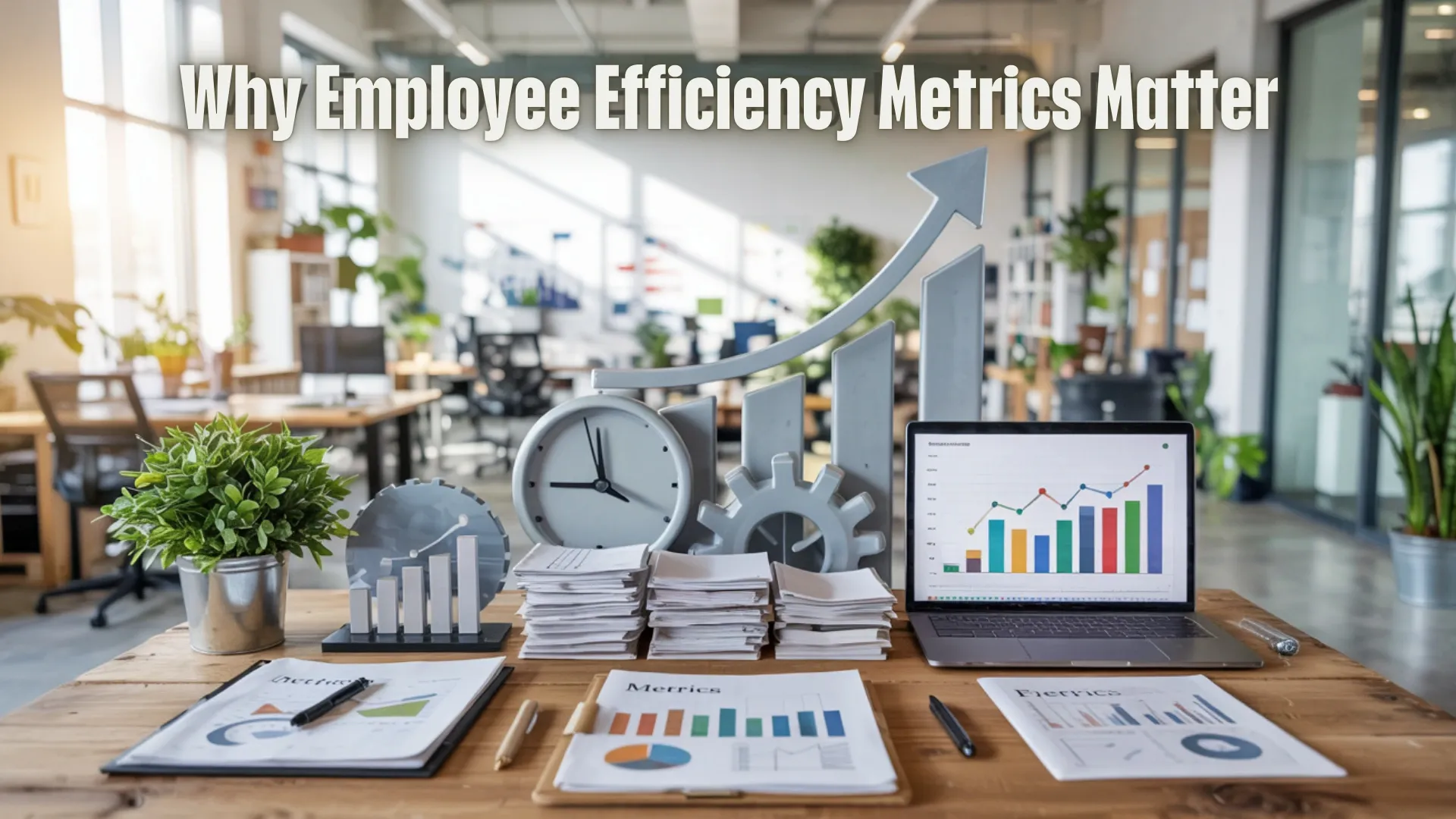
Key Summary:
-
A company can perform 4.2x better with a 24% higher profit margin when changes are made according to efficiency metrics evaluation.
-
Output per hour, task completion rate, work quality, and revenue per employee are critical metrics.
-
Employee performance metrics ensure productivity, identify areas for improvement, and boost overall company performance and growth.
-
Collecting 360-degree feedback, work quality measurement using SMART KPIs, implementing OKRs, etc., are best practices.
-
Achieving data for remote workers, over-monitoring, and growing trust issues are key challenges in measuring employee efficiency.
Efficiency is when maximum output for a given time is achieved with the highest quality of work. It’s that sweet spot every organization hunts for!
That said, employee efficiency metrics are more than just typical data points. They are the heartbeat of any organization that exhibits brilliance and areas to improve at the same time.
If you can’t recognize them, the metrics are nothing but mathematical gibberish. Hence, this write-up is my endeavor to show you why employee metrics make a difference.
In this article
- The importance of tracking employee efficiency
- Key workforce efficiency metrics to monitor
- How efficiency metrics boost business performance
- Challenges and best practices in measuring efficiency
What are Employee Efficiency Metrics and Why are They Important?
Employee efficiency metrics evaluate how effectively employees use their time and resources to complete tasks. And contribute to business goals. Such metrics play a pivotal role in business success.
These are some sort of benchmarks to understand the productivity levels. Then identify areas for improvement and make data-driven insights to boost performance. And create a positive employee experience.
According to McKinsey, organizations that use performance metrics are 4.2x more likely to be high-performing than those that don’t.
Studies also showed that companies that actively manage and measure employee productivity yield a 24% higher profit margin. This proves the measurable impact of implementing meaningful metrics.
Here’s why employee efficiency metrics are crucial:
Performance Optimization
Performance evaluation metrics show who’s doing well, who might be overloaded, and who needs support. Performance management systems provide actionable insights about team efficiency.
When you know who’s consistently delivering results, you can reward them and give promotions to keep them motivated. Therefore, engaged employees are more likely to aid positive business outcomes.
Moreover, you can identify skill gaps that are holding others back and work on improvements through professional development goals.
Monitor real-time productivity with one click
Resource Optimization & Cost Efficiency
Employee efficiency metrics optimize resources by measuring how well employees use their time and resources to get work done.
By analyzing these metrics, companies can spot inefficiencies, improve processes, and make better use of resources. Workforce metrics paint a clear picture of how well your human capital ROI is performing.
This leads to higher productivity and reduced costs. You should employ process improvements regarding these metrics to retain a collaborative work environment.
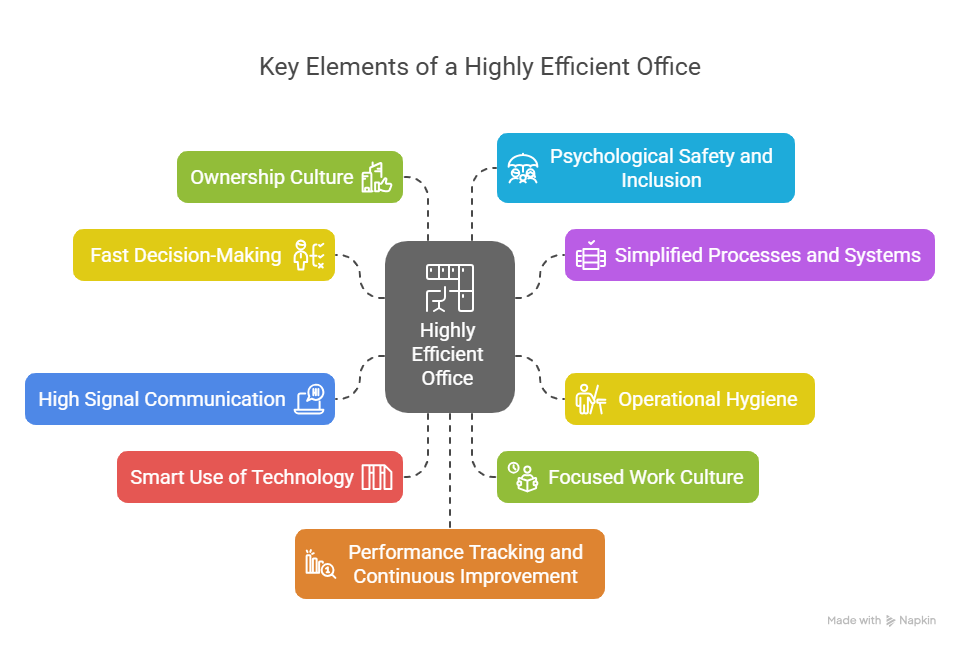
You can also pinpoint where you're spending money without getting much return.
Accountability and Transparency
Responsibility, accountability, and transparency are achieved by providing clear, measurable performance standards. Thanks to the efficiency metrics.
They help employees understand expectations, be responsible for meeting goals, and contribute to organizational success. All successful teams make use of these metrics.
These metrics create accountability as they track performance. Employees are held responsible for their work.
Particularly, existing performance gaps are easily identified through employee assessment tools. They provide real-time monitoring insights.
Efficiency metrics also promote transparency.
Since performance is measured against specific criteria, both employees and managers have access to the same data. So trust builds due to fair and consistent evaluations and consistent annual performance reviews.
Goal Alignment and Business Impact
According to Betterworks, employees are 35% more efficient when their goals clearly connect with company objectives. Gartner also found that performance can increase up to 22% when personal goals reflect broader organizational priorities.
Employee efficiency metrics help connect individual contributions to company goals. They show where time and effort are going.
So you can make data-backed strategic decisions.
Align goals with actionable insights today
Common Workforce Efficiency Metrics to Track

Output per Hour
The output per hour tells you how much work is completed in an hour. Gives a clear picture of overall productivity. The formula is:
Output per Hour = Total Output / Total Hours Worked
Use time-tracking tools to observe how work flows across a typical day. This metric measures productivity numerically. And provides invaluable insights for managers.
Now, divide the total amount of work completed by the total hours worked. The output is the baseline to work from.
Measure output accurately with time tracking
Task Completion Rate
Task completion rate tells you how many of the tasks assigned to your team are completed. The formula looks like this:
TCR = (Number of Completed Tasks / Total Number of Tasks) × 100
The formula directs that the task completion rate is 85%. For example, you assign your team 100 tasks, and they finish 85 of them. This is a key indicator of employee performance in many organizations.
Track task completion with precision
Utilization Rate
An employee’s available time spent on work that directly adds value translates to the utilization rate. The formula is:
Utilization Rate = (Total Billable Hours ÷ Total Available Hours) × 100
Suppose your employee works 40 hours a week and 34 of those hours are spent on billable tasks; their utilization rate is (34 ÷ 40) × 100 = 85%.
That means 85% of their time is going to client-focused or revenue-generating work. It’s an effective method for hybrid work models.
Low rates may suggest inefficiency; high rates can signal burnout.
Maximize billable hours with smart tracking
Quality of Work
To measure the quality of work, let’s start with the error rate. This tells you how often mistakes are being made during the process. It’s calculated like this:
(Total number of errors / Total number of units) x 100
In plain terms, it shows what percentage of the work had issues. If your error rate is high, that means your team is spending valuable time fixing things instead of moving forward. High-performing teams maintain low error rates while maintaining productivity.
Net promoter score
Send out a short survey asking your employees: “On a scale from 0 to 10, how likely are you to recommend this company as a great place to work?” This provides critical employee sentiment data.
Now, here’s how the responses are broken down:
- If someone gives you a 9 or 10, they’re a Promoter. They love the work, the workplace culture, and the vibe.
- If they pick a 7 or 8, they’re Passives. They’re content, not unhappy, but not exactly shouting your praises either.
- Anyone who picks 0 to 6 is a Detractor. They do not enjoy working here, and some might already be looking for the exit.
Now, calculate and subtract the percentage of detractors from the percentage of promoters. Employee experience metrics like this bring out valuable details.
A high eNPS means your team feels good about where they work. A low or negative score means something’s off.
Attendance and Punctuality
The attendance rate is how often employees show up for work during working days.
Here’s a simple formula to calculate it:
Attendance Rate = (Days Present ÷ Total Working Days) × 100
On the other hand, punctuality rate is how often employees come to the workplace on time.
Here’s the formula for that:
Punctuality Rate = (Days On Time ÷ Total Working Days) × 100
Tracking attendance and punctuality gives you real insight into your team’s habits. Employee analytics can reveal behaviors that hinder productivity.
Simplify attendance tracking effortlessly
Revenue per Employee
Revenue per employee means how much money your company earns for every person on the payroll.
To calculate it, you just take your total revenue and divide it by the number of employees.
Here’s the formula:
Revenue per Employee = Total Revenue / Number of Employees
Remember, not every single person is generating that amount directly. You can only guess how productive and efficient your workforce is overall. The function of employees in revenue generation can change due to role and department.
Maximize revenue with productivity insights
Skill Utilization
Skill utilization shows how well employees are spending their time on real productive tasks. To calculate skill utilization, we use:
Employee Utilization Rate = (Work Hours / Total Available Hours) × 100%
Tracking skill utilization identifies underused resources. Development metrics find where training is due.
Turnover Rate
Turnover rate means the percentage of employees who leave your company during a specific period.
To calculate the turnover rate:
Turnover Rate = (Number of Employee Departures / Average Number of Employees) × 100
A high turnover rate means poor management or a lack of career growth. On the other hand, a low turnover rate means employees are satisfied and more likely to stay long-term.
Tenure Rate
Tenure rate tells you how long employees stay with your company on average. The formula is:
Average Tenure = Total Years of Service / Number of Employees
A high tenure rate means your team members are satisfied in their roles. Employees who stay longer tend to be more experienced, more productive, and more committed to the company’s goals.
These are important employee experience KPIs that measure overall workspace health.
How Efficiency Metrics Help Improve Business Performance

Efficiency metrics show how your business is operating.
So, you can make better decisions, manage people and processes more effectively. A data-driven approach leads to better results.
Boosts Productivity and Performance
When people know their work is being tracked (not to micromanage, but to help), it often leads to better focus.
The feedback that comes from this tracking helps people stay aligned, correct mistakes early, and stay accountable. It gives better output, fewer delays, and a productivity boost in individual performance. Feedback mechanisms like this aid optimal performance.
Boost productivity with transparent tracking
Enables Data-Driven Decision
Efficiency metrics highlight what’s slowing your team down.
Is it a tool that’s outdated? A process that’s too manual? Or a handoff between departments that always causes delays?
And when you have those valuable insights, you can make process changes confidently. You can eliminate waste, automate repetitive work, streamline handoffs, and remove roadblocks.
Identifies Skill Gaps
Not every performance issue is a process problem.
Sometimes, people simply need more support. But without data, it’s hard to tell the difference.
So, employee development planning becomes difficult.
Efficiency metrics help you spot skill gaps early. Maybe one person is taking twice as long to complete the same task as others. Or maybe errors are consistently coming from the same part of a workflow.
Effective Resource and Workload Management
Every business has limited time, limited people, and limited tools. The challenge is using what you have in the best way possible.
When you track workloads and task completion times, it becomes clear who’s overloaded and who has room to take on more. You can shift tasks before burnout happens. You can spot gaps and reassign resources to where they’ll make the most impact.
It keeps your team running smoothly and improves morale.
Balance workloads with real-time insights
Challenges in Measuring Employee Efficiency
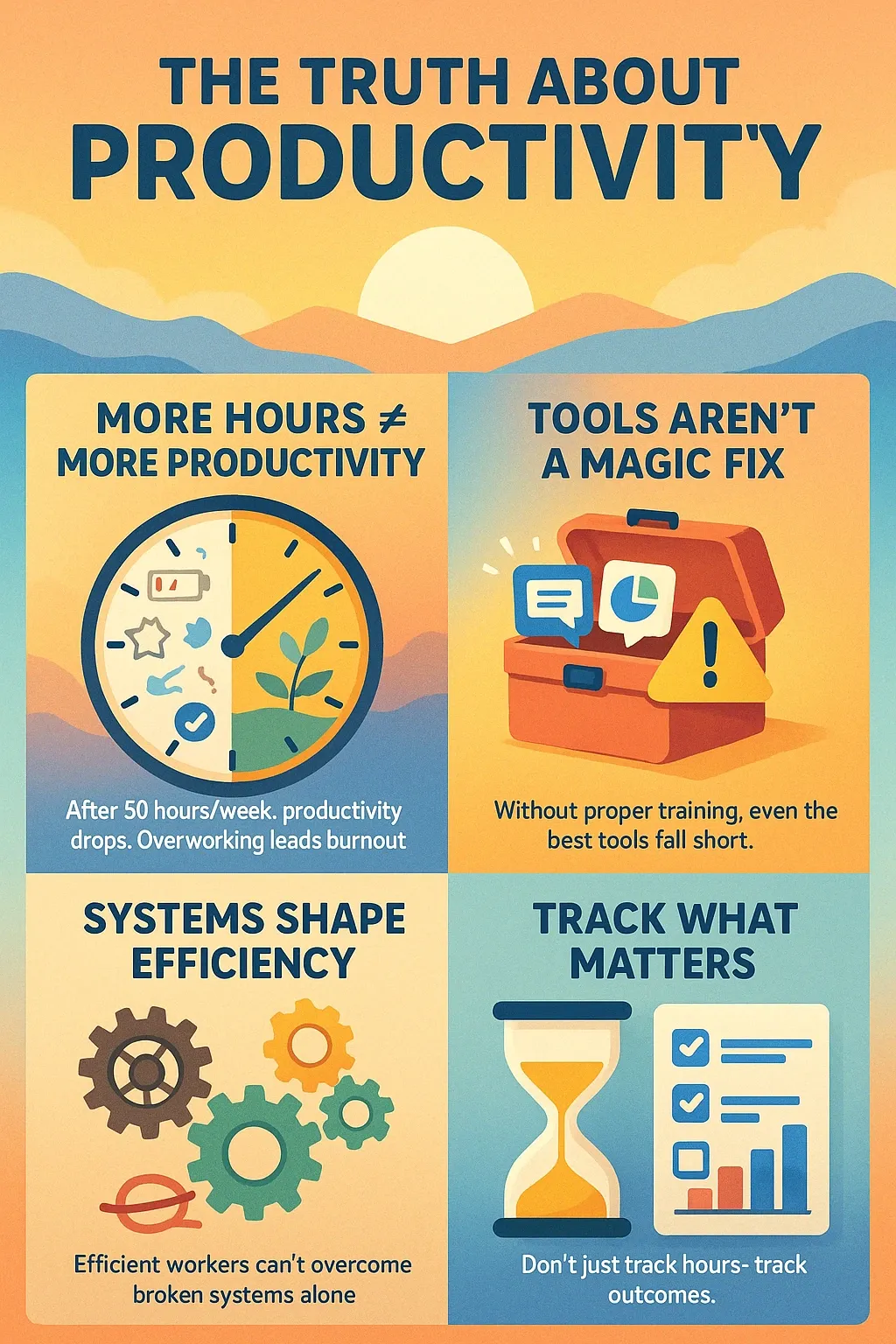
Selecting Relevant and Meaningful Metrics
Measuring workforce analytics is often shaped by more than just completed tasks. Sometimes, reviews reflect personal feelings instead of facts.
Biases like who someone gets along with or how they perceive others can affect how performance is rated.
When people feel misunderstood or overlooked, motivation drops. Making use of tools for improvement helps reduce bias in evaluations.
Collecting Accurate Data (Especially in Remote Settings)
Collecting employee efficiency data is challenging, especially when monitoring remote employees. Because it's harder to observe day-to-day behaviors, track real-time productivity, and differentiate between output and actual effort.
Hybrid office policies also need to clear up these measurement contradictions.
There's also a risk of invading privacy or creating distrust if monitoring feels too intrusive. Without physical presence, collaboration, distractions, or time zones can be easily missed.
Track remote work without invading privacy
Not Aligning with Organizational Goals
Too often, companies focus on surface-level key indicators like output or sales, without considering how those numbers support broader goals.
So employees may not see how they contribute to organizational success.
For example, McDonald's had to rethink its approach to productivity in 2019. Instead of just tracking sales, they began measuring customer feedback and sustainability efforts. This shift led to a 6% increase in global sales by 2021.
The challenge is to define the right metrics from the start. You need to understand your company’s values and long-term goals.
Without this alignment, operational efficiency indicators can feel empty or, worse, misleading.
Over-monitoring and Micromanagement
This is problematic when tracking employee efficiency turns into over-monitoring or micromanagement.
According to Forbes, 23% of employees feel constantly watched. And nobody likes feeling watched all the time.
They think that you don’t trust them. And once trust is gone, so is motivation. Instead of focusing on their work, employees start worrying about being judged.
6 Best Practices in Measuring Employee Efficiency
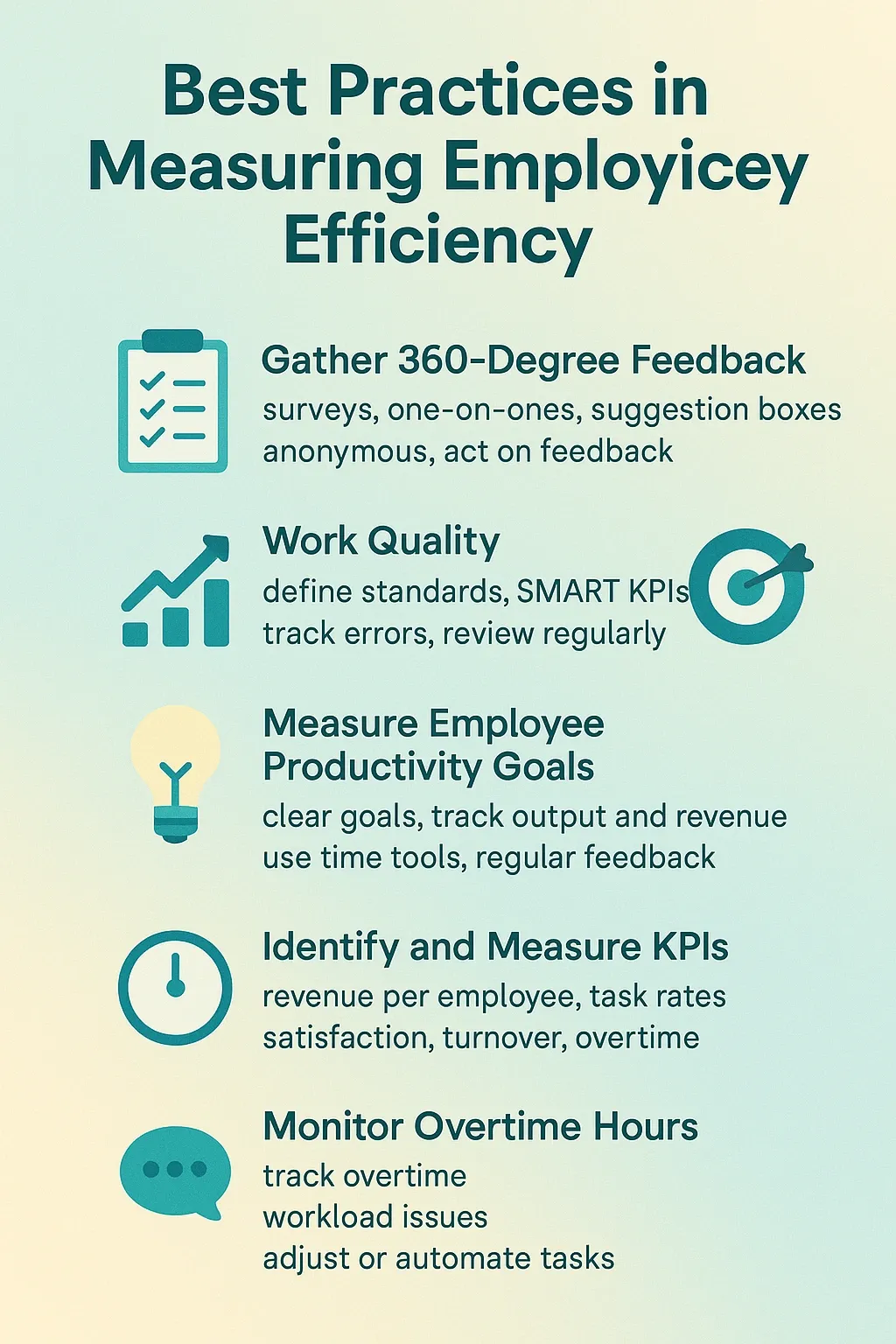
Measuring employee efficiency is about understanding how work gets done and where it can be optimized. To do it well, these are the best practices that you must follow:
Gather 360-degree Feedback
Honest, clear, and regular 360-degree feedback goes a long way. Casual one-on-ones, employee engagement surveys, and even something as simple as a suggestion box can open the door.
Make it safe. Keep things anonymous when needed. More importantly, follow through. When someone shares employee input, show them it's not going into a black hole. Feedback forms can organize the process for more collective results.
Work Quality
First, define what high-quality work looks like for each role. Then set SMART KPIs, and align them with your business goals.

Next, use the right metrics. Track error rates to spot accuracy issues, monitor task completion rates, and review customer feedback for real-world insight.
Include Employee Net Promoter Scores (eNPS) to understand how engaged and quality-focused your team feels.
Feedback is a must. Use regular reviews, 360-degree input, regular surveys, and self-assessments to catch problems early and guide improvement.
Measure Employee Productivity Goals
To measure employee productivity the right way, start with clear common goals. Make sure they’re specific, measurable, and realistic. When people know exactly what’s expected, they work with more focus and purpose.
Next, track the right numbers. Look at output per hour, task completion rates, and even revenue per employee. These metrics show how efficient your employees are.
Use Time tracking software like Apploye to keep track. This tool makes it easier to see who’s doing well and who might need support. Employee management software is incomparable in improving overall performance.
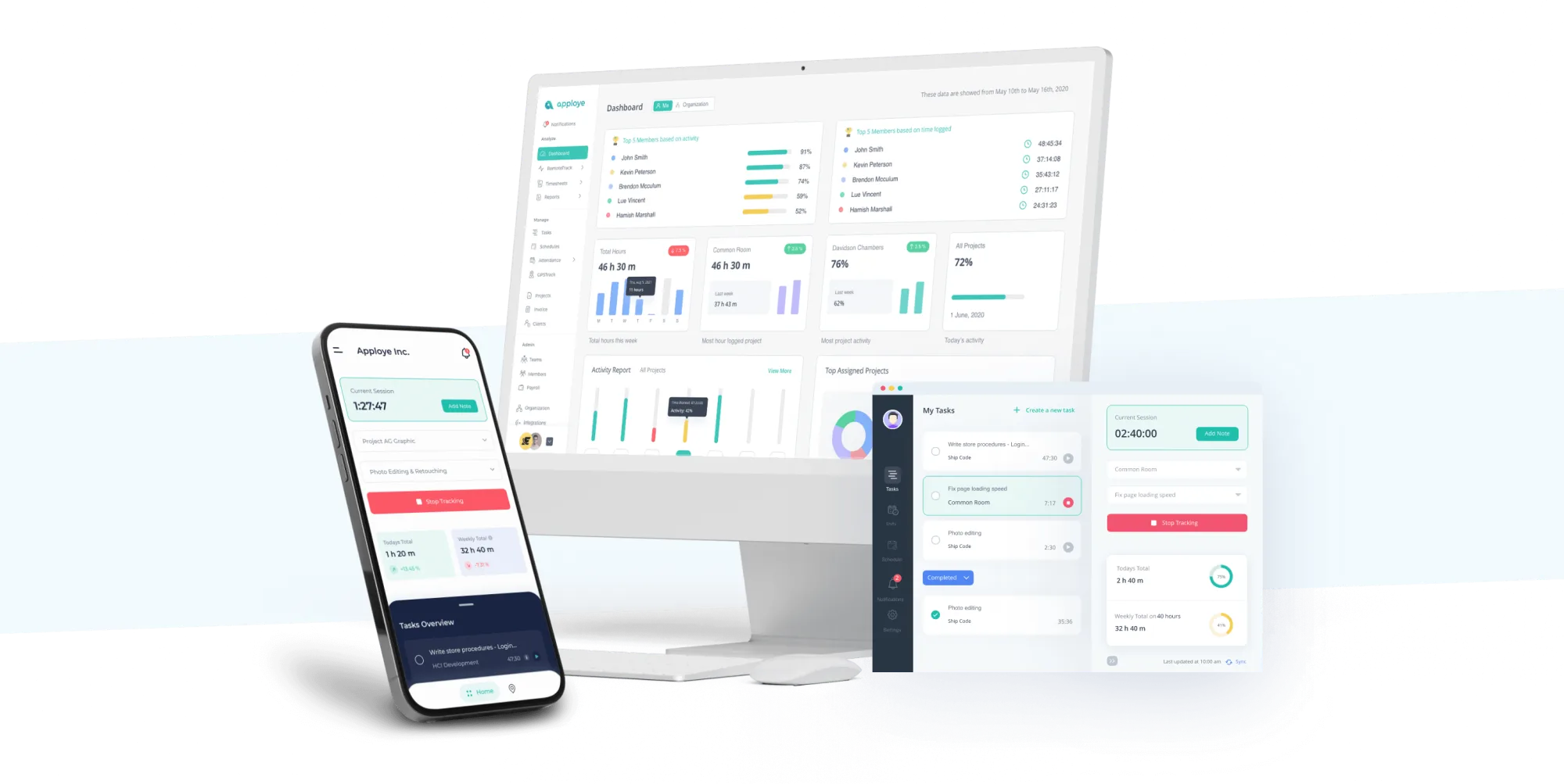
Talk to your team. Give feedback often and help them grow with training. Finally, review individual goals and processes regularly.
Start tracking productivity in minutes
Identify and Measure KPIs
To measure employee efficiency, start with the right KPIs.
Revenue per employee tells you how much value each person brings to the business. Task completion rate shows how quickly and accurately work gets done.
Customer satisfaction scores show how your team’s work affects the customer experience. Employee engagement scores help you understand how involved and motivated they are.
Often check employee turnover and absenteeism. Also, track quality of work and overtime hours to spot burnout or inefficiencies.
To get the most from these KPIs, set clear goals and measurable targets. Monitor them regularly. If something’s off, adjust.
Monitor Overtime Hours
First, make sure your team knows exactly when overtime is okay.
Next, track time accurately. Use tools that make it easy to record work hours. Once you have that data, review it.
Then find answers to these questions:
- Are certain employees always working late?
- Are some teams stretched too thin?
If overtime is piling up, it may be time to relook at workloads or how tasks are assigned. Maybe some work can be automated or better prioritized. It keeps your team productive and prevents burnout.
OKRs (Objectives and Key Results)
OKRs are one of the easiest ways to track how well your team is working. You set a clear goal or the strategic objectives, then break it down into 2–4 key results that show employee progress.
For OKRs to actually work, everyone needs to see them. When goals are open and visible, it’s easier for teams to stay in sync. Regular check-ins help too. Don’t wait until the end to see what’s going wrong.
Too many goals confuse staff and lead to half-done work. Focus on what really matters. Ensure it ties back to your company’s bigger picture.
Also, let your team be part of the process. When people help set their own goals, they care more about reaching them.
Track OKRs with intuitive progress views
Conclusion
If you want to improve efficiency, boost productivity, and keep the team motivated, you need the right metrics.
But no single metric tells the full story. People aren’t numbers, and work isn’t one-size-fits-all.
That’s why I suggest implementing different metrics to see what’s really going on. It helps you understand your people better and lets them grow.
Start your productivity transformation today
Frequently Asked Questions About Employee Efficiency Metrics Measurement
Why is it important to measure employee performance?
Measuring employee performance helps businesses see how well people are working. It shows strengths, areas to improve, and makes sure everyone is working toward the same goals. It also supports employee growth, boosts motivation, and helps teams work better together.
Why is monitoring productivity important for businesses?
Monitoring productivity helps people work better and faster. It shows what needs fixing, who is doing well, and how to use resources wisely. It also helps make smart choices, keeps employees motivated, and follows rules.
What are employee efficiency metrics?
Employee efficiency metrics measure how well an employee uses their time and resources to complete tasks. It tracks performance, spot areas for improvement, and boosts productivity.
How can you increase employee efficiency?
To boost employee efficiency, streamline workflows, ensure they have the right tools, and create a culture of open communication and support. Set specific goals, offer ongoing training, and actively recognize great performance to keep motivation and productivity high.
How to choose the right employee metrics for your team?
To choose the right employee metrics for your team, first understand your company’s goals and the roles within your team. Track what’s actually measurable, like productivity, satisfaction, retention, or turnover. So you can see what’s working and where to improve.
What productivity metrics should you measure?
To measure your team’s productivity, look at efficiency and how well your team uses resources. Metrics like revenue per employee, task completion rate, cycle time, and employee engagement are also helpful. They give you a well-rounded view of what’s getting done and how smoothly it’s happening.
What are employee performance metrics?
Employee performance metrics are measurable indicators that help assess how well someone is doing their job. They give managers a clear, data-driven view of productivity, efficiency, and overall impact. It makes it easier to spot strengths, address gaps, and guide decisions on things like training or promotions.
Why are performance metrics important?
Performance metrics measure how well a company is doing and help guide actions for growth. It shows what's working, where adjustments are needed, and keeps everyone focused on common goals.
How can employee performance metrics be used to drive continuous improvement?
Employee performance metrics help spot strengths and areas for growth. They guide training, align with company goals, and support better decisions. Regular feedback keeps employees growing, and metrics help improve processes and keep motivation high.
Why is it important to formalize performance metrics and key performance indicators (KPIs) in the budgeting process?
Using key performance metrics in budgeting ensures money is spent on the right things to meet goals. It also uses resources well.
What are the biggest reasons for and against using stats to drive productivity in a workplace?
The biggest reason to use stat is that it improves efficiency, allocates resources better, and engages employees. But overemphasizing employee metrics might overlook significant qualitative factors like employee well-being and team morale.
Which employee performance metrics are most useful to managers and why?
Key metrics like goal attainment, task completion, customer feedback, work quality, and attendance help managers assess employee performance. They show how productive employees are and how efficiently they complete a task.
Is it true that tracking employee productivity is necessary for effective management?
Yes, tracking employee productivity metrics manages and improves performance by showing where to focus on efficiency. However, it's important to focus on results, not methods, to keep employee morale high and avoid harming productivity.
What unique performance metrics can HR managers analyze to identify future leaders within their organization?
To identify future leaders, HR managers can assess metrics like 360-degree feedback, leadership credibility surveys, and 9-box grids. Tracking internal mobility, development investment, and the percentage of high-potential talent shows who’s ready to lead next.
Why is employee engagement a crucial KPI for companies to measure?
Employee engagement is a crucial KPI because it directly influences productivity, employee retention, and overall company performance. Tracking it helps businesses understand how connected and motivated their teams feel.
What is the significance of revenue per employee in measuring staff productivity?
Revenue per employee (RPE) shows how efficiently a company is leveraging its workforce to generate income. A higher RPE means employees are contributing more to revenue. A lower RPE may highlight areas where productivity or resource allocation can be improved.
What are the KPIs or metrics you, as a PM, look at while managing remote work?
As a PM managing remote work, I focus on KPIs like employee productivity rate and project completion rate. This shows how many projects are delivered on time. I also look at the employee satisfaction score, which helps me understand how engaged and happy the team feels working remotely.
What are the most important HR metrics?
The most essential HR metrics focus on recruitment, retention, employee engagement, diversity, and performance. These key indicators provide valuable insights into the success of HR strategies. They also help leaders make informed, data-driven decisions to improve overall organizational health.

